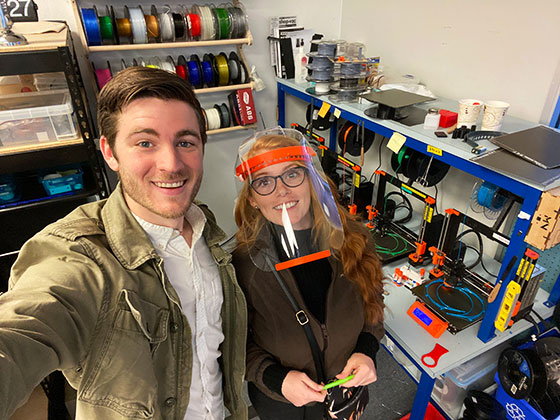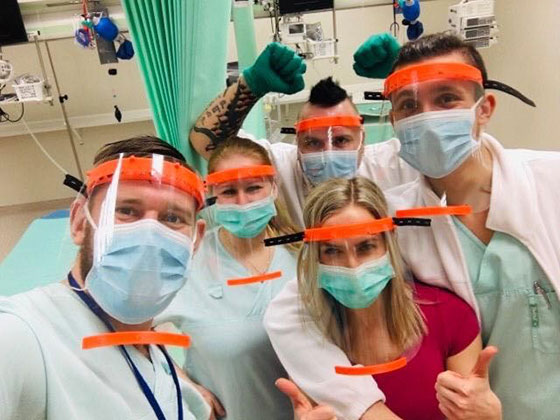USF Art Alumna Tina Piracci Leads Initiative to Supply Healthcare Workers with 3D-Printed Protective Gear
Tuesday, May 05, 2020

USF art alumna Tina Piracci demonstrates 3D printed face shield with fellow UC Berkeley student Dylan Arceneaux at the Maker Nexus fabrication space in Sunnyvale, CA.
With the COVID-19 pandemic straining the existing supply chain of personal protective equipment (PPE), people all over the world are coming up with creative ways of protecting healthcare workers working on the front lines.
One such person is USF art alumna Tina Piracci, who in response to the pandemic co-founded the C19 Bayshield initiative to leverage 3D printing technology and the talents of her peers to meet the demand for personal protective gear through a grassroots movement.
“From students in their living rooms and kitchens to maker spaces that have an array of fifty printers, people are coming together all over to sort of try to help what skills or materials they have,” said Piracci in a video call in early April.
Piracci is currently a graduate architecture student at UC Berkeley, where she researches 3D printing materials and methods of leveraging 3D printing technology to solve social and climate issues. As a student at USF, she earned not only a BFA in fine arts but also a minor in Entrepreneurship as well as certificates in Visualization and Design and Electrical Engineering, Digital Design and The Arts. She is currently working with her peers to produce, distribute, and track orders for protective gear from local healthcare facilities.
Tina and the C19 Bayshield team are producing PPE in a variety of ways. They are running
their own 3D printers at home 24/7. In Tina's case, she can produce materials for
about 15 face shields per day. They are working in conjunction with the non-profit
Maker Nexus, a non-profit makerspace in the San Francisco Bay Area, to distribute
PPE.

Medical professionals wear face shields 3D printed by the C19 Bayshield team.
In early April, the team secured permission to use the 3D printers at Berkeley for the cause, greatly scaling their production abilities with rows of capable 3D printers.
With such overwhelming demand, the top priorities for the group include organizing the influx of orders, developing an app for coordinating orders and production, and getting others to donate resources to the movement.
Currently, the team manages its orders from San Francisco Bay Area medical facilities through the use of existing technologies like Google Drive. This has helped them to deliver over 8,000 pieces of personal protective equipment to hospitals and senior centers in San Francisco. The team also garnered the attention of Apple Inc., which donated 3,000 face shields to C19 Bayshield.
Despite the success, challenges remain. With such a massive demand, prioritizing orders from facilities with the most critical needs—such as facilties without any face shields—becomes paramount. That is why the team is developing an app to streamline the PPE order process for medical professionals and makers to efficiently deliver gear to facilities with the most need.
“There are doctors out there intubating patients that don't have a face shield at all,” said Piracci.
Once an app is developed, it can be scaled to be used in other communities, where people with 3D printers, laser cutters, sewing machines, and more are already working to meet the need for protective gear.
“Luckily at UC Berkeley we have a lot of great app developers and coders and people with a lot of experience,” said Piracci, “so we've been starting this initiative to get it out as soon as possible.”
The team is currently running a gofundme campaign to fund server space for the app and materials, such as filament—the raw material used to print their designs.
Piracci is calling on all people with manufacturing skill sets and equipment to join this grassroots effort to protect medical workers and the broader community. She implores makers to join groups online, such as the Facebook group Open Source COVID19 Medical Supplies - Central and South Florida, to connect with other makers and healthcare facilities in your area.
But before starting to create, Piracci implores volunteers to use the existing frameworks.
“I urge people that are makers: either use sewing patterns that already exist, use the designs that are already out there and are approved and we know work,” said Piracci. “This isn't the time to prototype to find some new solution. They're already out there.”
People with 3D printers, laser cutters, sewing machines, and other types of equipment can download open-source designs to ensure that their creations will be safe and useful to workers on the front lines. Even those who do not have manufacturing skills and equipment can still get involved by leveraging the power of their diverse, multidisciplinary talents.
She cites an example from one of the online groups where a graphic designer and a geologist were able to come connect and collaborate to create maps that benefit the organization of the grassroots movement.
Despite the uncertainty, Piracci and her team are showing what is possible with a little creativity and the powering of emerging technology. What began as the study of her passions for art and technology at USF prepared Piracci to delve deeper into socially fueled tech projects at Berkeley.
“I feel like now, more so than ever its coming together and I'm able to combine my interests and put them to better use here,” said Piracci.
Resources
Visit c19bayshield.org for more information.
Donate to the C19 Bayshield gofundme campaign.
Interested in getting involved? Visit the Open Source COVID19 Medical Supplies national group on Facebook as well as its central and south Florida subsidiary.